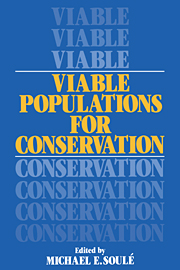Book contents
- Frontmatter
- Contents
- List of contributors
- Preface
- 1 Introduction
- 2 The demography of chance extinction
- 3 Extinction models and mammalian persistence
- 4 Minimum viable population size in the presence of catastrophes
- 5 Minimum viable populations: coping with uncertainty
- 6 Effective population size, genetic variation, and their use in population management
- 7 Spatial structure and population vulnerability
- 8 Managing critically endangered species: the Sumatran rhino as a case study
- 9 The role of interagency cooperation in managing for viable populations
- 10 Where do we go from here?
- Index
2 - The demography of chance extinction
Published online by Cambridge University Press: 21 January 2010
- Frontmatter
- Contents
- List of contributors
- Preface
- 1 Introduction
- 2 The demography of chance extinction
- 3 Extinction models and mammalian persistence
- 4 Minimum viable population size in the presence of catastrophes
- 5 Minimum viable populations: coping with uncertainty
- 6 Effective population size, genetic variation, and their use in population management
- 7 Spatial structure and population vulnerability
- 8 Managing critically endangered species: the Sumatran rhino as a case study
- 9 The role of interagency cooperation in managing for viable populations
- 10 Where do we go from here?
- Index
Summary
With many sorts of habitats and some entire ecosystems dwindling in extent, the extinctions of many species are imminent. Attempts at saving some of these species as ecologically functioning members of more or less natural communities, rather than zoo populations, involve the establishment of reserves whose extent is very modest in comparison to the original range of the species, and which, for that reason, can only maintain comparatively small relict populations. We wish, therefore, to estimate the viabilities of these small populations, and to learn what management measures and reserve-design features will enhance their viabilities. Furthermore, since there is inevitably pressure, in a crowded world, to encroach upon reserves, we should like to estimate the minimum extent of a reserve that will suffice to confer upon a population an expected time of extinction that is, by some criterion, acceptably remote. We shall scale this measure of reserve extent in units of population size. This is the minimum viable population problem.
At the most elementary level, the minimum viable population problem can be framed in demographic terms; but the magnitudes of the demographic variables will depend on a variety of factors, such as habitat quality, environmental variation, and genetic composition of the population (Shaffer, 1981; Soulé, 1980).
- Type
- Chapter
- Information
- Viable Populations for Conservation , pp. 11 - 34Publisher: Cambridge University PressPrint publication year: 1987
- 200
- Cited by



